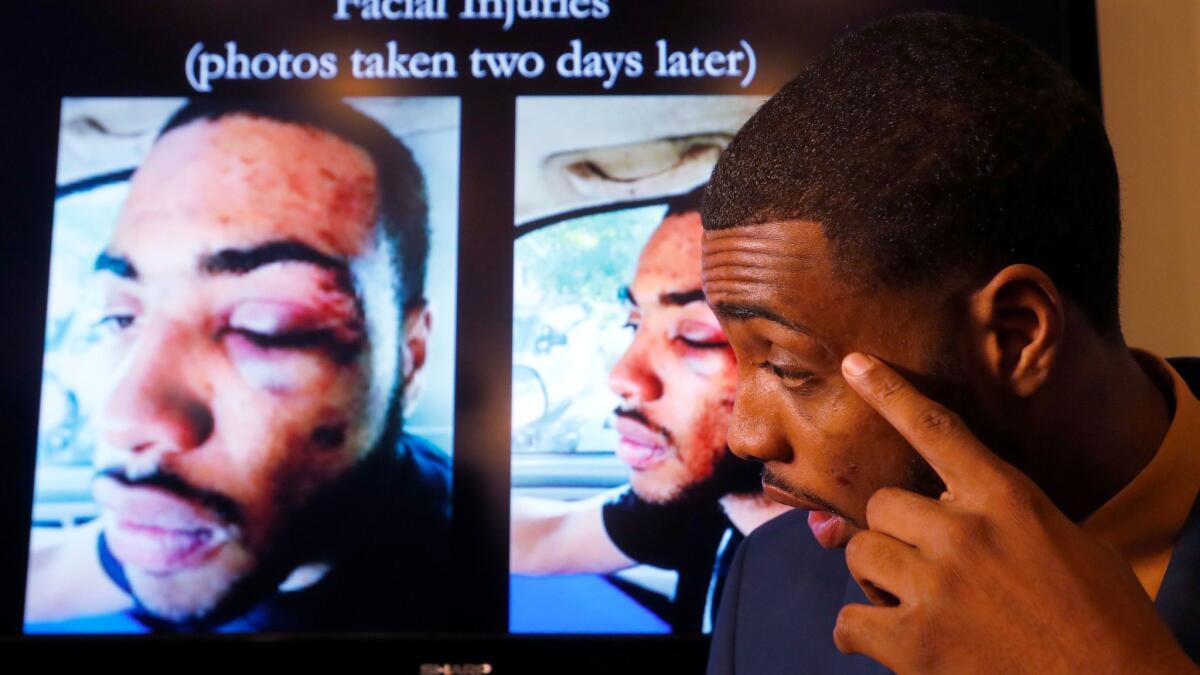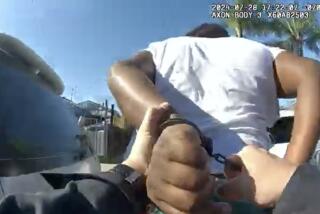Videos showing violent arrest of a black motorist renew concern about Pasadena police tactics

Raw Video: Pasadena police release body-cam footage of scuffle that left man with broken leg.
- Share via
It should have been the most minor of traffic stops.
But an encounter between two Pasadena police officers and a black motorist last month has reignited the nation’s heated debate over how police use force and sparked outrage in a city with long-simmering complaints about how law enforcement treats African American men.
Videos captured by the police and a bystander show one officer repeatedly hitting the unarmed motorist with a baton during the Nov. 9 incident at an Altadena gas station. Another officer screams at the struggling man to give up his hands and punches him at least five times before slamming his face into the asphalt. Finally, the officers manage to handcuff him behind his back.
“I didn’t even do anything,” the handcuffed man whimpers as blood pools around his head.
The graphic images have made international headlines at a time when many police agencies around the country have been training officers on how to “de-escalate” encounters with civilians and avoid using force if possible. Though one prominent police force expert defended the officers’ actions, others interviewed by The Times questioned how the officers weren’t able to keep the encounter calm and prevent it from turning violent so quickly.
The American Civil Liberties Union of Southern California called for criminal charges against the officers, describing their actions as “clearly unnecessary, excessive and unlawful.” And civil rights activists said the altercation highlights the need for independent oversight of the city’s Police Department.
“The fact is the Police Department has a long history of profiling young African American males,” said Skip Hickambottom, a Pasadena civil rights attorney.
Martin Gordon, an activist with the Pasadena Community Coalition, compared the video to the infamous 1991 recording of Los Angeles police officers using batons to beat black motorist Rodney G. King. Gordon criticized how little Pasadena city and police officials have said about the episode.
“This has got to stop,” he said. “We have to do something to move the department and city of Pasadena to accountability in this area.”
The view from police cameras
In response to criticism, the city released six police recordings of the incident, the first time Pasadena has made police body camera videos public since officers began using the equipment last year.
Pasadena officials have stopped short of publicly defending the officers, but city spokesman William Boyer urged the public to view all of the recordings for a complete view of what happened.
He noted that the motorist, 21-year-old Christopher Ballew, initially walked away from officers when they first approached him and then pulled away as they tried to handcuff him. During the struggle, Ballew can be seen briefly grabbing an officer’s baton as he was being struck.
“You see the grabbing of the officer’s baton during the struggle and the officers’ subsequent actions to control the situation,” Boyer said in an email.
The Police Department is conducting an internal investigation, he said. Meanwhile, the officers, Lerry Esparza and Zachary Lujan, remain on duty.
City officials have released few other details about what happened and declined to comment further.

After his arrest, Ballew was booked on suspicion of assaulting a peace officer with a deadly weapon and held in jail for more than a day before being released on bail. The district attorney’s office declined to file charges against him, citing a lack of evidence.
Ballew, whose leg was broken, announced this week that he has filed a legal claim against the city, the Police Department and the officers.
‘Under siege’
For some Pasadena residents, the altercation echoes other controversial incidents involving black men that have spurred calls for police reform.
The 2009 killing of Leroy Barnes Jr. inflamed tensions in the northwest area of the city, where poverty and crime is higher than surrounding neighborhoods. Barnes, an admitted gang member on parole, was armed with a gun. But residents questioned why he was shot 11 times, including as he was lying facedown on the ground.
Three years later, Pasadena police shot and killed 19-year-old Kendrec McDade after a false 911 report of an armed robbery. The district attorney’s office cleared officers of criminal wrongdoing, but an independent consultant hired by the city faulted them for making tactical mistakes that helped lead to the shooting and criticized the Police Department’s investigation into the killing.
Last year, more than 500 people marched through the heart of Pasadena after the death of Reginald Thomas Jr., who had a history of mental illness. Police said Thomas, 35, was armed with a knife and a fire extinguisher and was uncooperative. An attorney for Thomas’ family said police used excessive force when he was Tasered, then kicked in the head and hit with a baton.
A 2016 city-commissioned study found that many people of color in Pasadena — a city of roughly 140,000 where African Americans make up 11% of the population — reported feeling “under siege in their neighborhoods” and alienated from police.
Ya’ll just assaulted me.
— Christopher Ballew to Pasadena police officers immediately after he was handcuffed
In the most recent incident, recordings show officers making a U-turn to follow Ballew’s white Mercedes sedan into a Mobil gas station. Police later said they stopped him because the car was missing a front license plate and its tinted windows were too dark.
After a brief exchange near the gas station’s mini-market, an officer grabs Ballew’s left arm and guides him back to his car, then pushes him against the vehicle, pulling his left arm behind his back. It’s not clear why the officers began using force so quickly.
“You better stop acting like a dummy, dude,” one officer says as they struggle to handcuff Ballew.
“Come on, man,” Ballew responds. “You doing that extra … for what?”
The officers demand Ballew’s hands and begin separating his feet, forcing him to the ground. Ballew continues to protest, while the officers order him not to get up.
“What are you doing this for?” Ballew asks.
As one officer starts to cuff Ballew’s left wrist, Ballew demands to know where their commanding officer is.
“Shut the … up,” one officer says, using an obscenity.
Despite the officer’s orders, Ballew appears to pull his right wrist away as the officers continue struggling to get both of his wrists into handcuffs.
Then they tumble.
“He has the cuffs. He won’t give me his hands,” one of the officers tells the other, then broadcasts on his radio that they are in a fight.
The video shows an officer striking Ballew with a baton. Ballew stands and briefly grabs the weapon before the other officer takes him to the ground.
One punches Ballew several times in the head. The other officer briefly draws his handgun, then reholsters it and picks up the baton, which he uses to strike Ballew three more times.
“Ya’ll just assaulted me, bro,” Ballew says after he is cuffed.
“There’s no point in acting like this,” one of the officers responds.
Reducing tensions, avoiding force
Several police force experts said the violence could have been avoided.
Seth Stoughton, a law professor at the University of South Carolina and a former Tampa police officer, said the officers should have tried to reduce the initial tension by emphasizing to Ballew the minor nature of the traffic infraction.
Stoughton said that the video doesn’t show the entire story and that it’s unclear how strongly Ballew is resisting. A struggling suspect who has only one handcuff on can use the cuff as a weapon, he said. Still, Stoughton said the video shows the officers shouting orders at Ballew — to put his hand on his head — that he appears to already be following.
“I am not absolving this man of responsibility, but the police are paid trained professionals here,” Stoughton said.
Ed Obayashi, a Plumas County sheriff’s deputy and legal advisor who teaches use of force to police, said the outcome could have been very different if the officers had adopted a different tone.
“Another officer and this may have never happened,” he said.
But the officers, he said, were justified in feeling threatened and using force when Ballew broke free with one wrist cuffed.
Charles “Sid” Heal, a retired Los Angeles County sheriff’s commander, called the force reasonable.
“If you fight with the police, bad things happen,” Heal said. “You can see on the videos a number of times when he is resisting being handcuffed.”
Ballew’s attorney, John Burton, said his client’s encounter was not a typical occurrence in the city.
“They’ve had some high-profile shootings … but they’re really not the kind of force that regularly goes out and beats people up,” he said.
However, Burton said he was alarmed at the “non-reaction” by the Police Department and City Council.
“When some of these police officers feel like they can do something like this with video recording … and there’s no ramifications,” he said, “maybe there’s something wrong here.”
For more Southern California news, follow us on Twitter: @makedaeaster and @lacrimes
More to Read
Sign up for Essential California
The most important California stories and recommendations in your inbox every morning.
You may occasionally receive promotional content from the Los Angeles Times.












